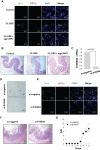Interleukin-6 induces S100A9 expression in colonic epithelial cells through STAT3 activation in experimental ulcerative colitis
- PMID: 22962574
- PMCID: PMC3433486
- DOI: 10.1371/journal.pone.0038801
Interleukin-6 induces S100A9 expression in colonic epithelial cells through STAT3 activation in experimental ulcerative colitis
Abstract
Background: Intestinal epithelium is essential for maintaining normal intestinal homeostasis; its breakdown leads to chronic inflammatory pathologies, such as inflammatory bowel diseases (IBDs). Although high concentrations of S100A9 protein and interleukin-6 (IL-6) are found in patients with IBD, the expression mechanism of S100A9 in colonic epithelial cells (CECs) remains elusive. We investigated the role of IL-6 in S100A9 expression in CECs using a colitis model.
Methods: IL-6 and S100A9 expression, signal transducer and activator of transcription 3 (STAT3) phosphorylation, and infiltration of immune cells were analyzed in mice with dextran sulfate sodium (DSS)-induced colitis. The effects of soluble gp130-Fc protein (sgp130Fc) and S100A9 small interfering (si) RNA (si-S100A9) on DSS-induced colitis were evaluated. The molecular mechanism of S100A9 expression was investigated in an IL-6-treated Caco-2 cell line using chromatin immunoprecipitation assays.
Results: IL-6 concentrations increased significantly in the colon tissues of DSS-treated mice. sgp130Fc or si-S100A9 administration to DSS-treated mice reduced granulocyte infiltration in CECs and induced the down-regulation of S100A9 and colitis disease activity. Treatment with STAT3 inhibitors upon IL-6 stimulation in the Caco-2 cell line demonstrated that IL-6 mediated S100A9 expression through STAT3 activation. Moreover, we found that phospho-STAT3 binds directly to the S100A9 promoter. S100A9 may recruit immune cells into inflamed colon tissues.
Conclusions: Elevated S100A9 expression in CECs mediated by an IL-6/STAT3 signaling cascade may play an important role in the development of colitis.
Conflict of interest statement
Figures





Similar articles
-
Nitazoxanide protects against experimental ulcerative colitis through improving intestinal barrier and inhibiting inflammation.Chem Biol Interact. 2024 May 25;395:111013. doi: 10.1016/j.cbi.2024.111013. Epub 2024 Apr 23. Chem Biol Interact. 2024. PMID: 38663798
-
Fibroblast Growth Factor 20 Attenuates Colitis by Restoring Impaired Intestinal Epithelial Barrier Integrity and Modulating Macrophage Polarization via S100A9 in an NF-κB-Dependent Manner.Cell Mol Gastroenterol Hepatol. 2025;19(6):101486. doi: 10.1016/j.jcmgh.2025.101486. Epub 2025 Feb 28. Cell Mol Gastroenterol Hepatol. 2025. PMID: 40024533 Free PMC article.
-
MicroRNA214 Is Associated With Progression of Ulcerative Colitis, and Inhibition Reduces Development of Colitis and Colitis-Associated Cancer in Mice.Gastroenterology. 2015 Oct;149(4):981-92.e11. doi: 10.1053/j.gastro.2015.05.057. Epub 2015 Jun 6. Gastroenterology. 2015. PMID: 26055138 Free PMC article.
-
Development, validation and implementation of an in vitro model for the study of metabolic and immune function in normal and inflamed human colonic epithelium.Dan Med J. 2015 Jan;62(1):B4973. Dan Med J. 2015. PMID: 25557335 Review.
-
STAT3-Activating Cytokines: A Therapeutic Opportunity for Inflammatory Bowel Disease?J Interferon Cytokine Res. 2015 May;35(5):340-50. doi: 10.1089/jir.2014.0225. Epub 2015 Mar 11. J Interferon Cytokine Res. 2015. PMID: 25760898 Free PMC article. Review.
Cited by
-
Transition metal ions at the crossroads of mucosal immunity and microbial pathogenesis.Front Cell Infect Microbiol. 2014 Jan 24;4:2. doi: 10.3389/fcimb.2014.00002. eCollection 2014. Front Cell Infect Microbiol. 2014. PMID: 24478990 Free PMC article. Review.
-
Intestinal inflammation marker calprotectin regulates epithelial intestinal zinc metabolism and proliferation in mouse jejunal organoids.Biomed Pharmacother. 2024 May;174:116555. doi: 10.1016/j.biopha.2024.116555. Epub 2024 Apr 8. Biomed Pharmacother. 2024. PMID: 38593708 Free PMC article.
-
Nicotine protects against DSS colitis through regulating microRNA-124 and STAT3.J Mol Med (Berl). 2017 Feb;95(2):221-233. doi: 10.1007/s00109-016-1473-5. Epub 2016 Oct 5. J Mol Med (Berl). 2017. PMID: 27709266
-
Decreased S100A9 expression alleviates Clostridium perfringens beta2 toxin-induced inflammatory injury in IPEC-J2 cells.PeerJ. 2023 Jan 25;11:e14722. doi: 10.7717/peerj.14722. eCollection 2023. PeerJ. 2023. PMID: 36718447 Free PMC article.
-
Gingival crevicular fluid as a source of biomarkers for periodontitis.Periodontol 2000. 2016 Feb;70(1):53-64. doi: 10.1111/prd.12107. Periodontol 2000. 2016. PMID: 26662482 Free PMC article. Review.
References
-
- Podolsky DK. Inflammatory bowel disease (1). N Engl J Med. 1991;325:928–937. - PubMed
-
- Maloy KJ, Powrie F. Intestinal homeostasis and its breakdown in inflammatory bowel disease. Nature. 2011;474:298–306. - PubMed
-
- Baumgart DC, Carding SR. Inflammatory bowel disease: cause and immunobiology. Lancet. 2007;369:1627–1640. - PubMed
Publication types
MeSH terms
Substances
LinkOut - more resources
Full Text Sources
Other Literature Sources
Medical
Molecular Biology Databases
Miscellaneous

